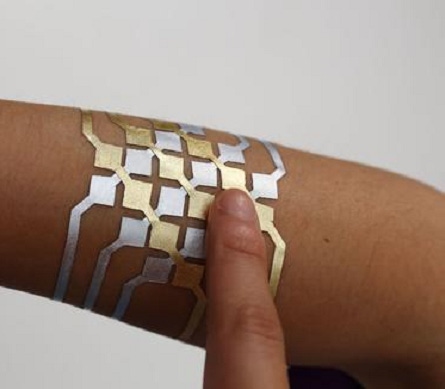Microsoft, MIT Create 'Smart' Tattoo For Phone Control
A team of Microsoft researchers and MIT PhD students have developed a temporary tattoo that doubles as a smartphone touchpad.


7 Cool Data Center Innovations
7 Cool Data Center Innovations (Click image for larger view and slideshow.)
Microsoft Research and MIT Media Lab PhD students have teamed up to create the next level of wearable: Temporary smart tattoos. This experimental type of smart device can be used to control electronics or send data through NFC.
The technology is named DuoSkin. In a paper on the topic, MIT describes DuoSkin as a "fabrication process" through which anyone can create a custom-built device that is attached to the skin and functions as a user interface.
These devices, or tattoos, are made of gold metal leaf. The material was chosen because it is inexpensive and skin-friendly. It can also withstand day-to-day wear.
One of the ideas behind this project was to make wearable devices more accessible. Everyday devices have become compact enough to be worn as accessories or attached to the skin. MIT explains how skin-based electronics have added potential because they give direct access to the wearer's biometric data.
However, creating "epidermal electronics" is pricey and requires obscure materials often limited to medical and material sciences. Researchers want to expand on-skin wearables beyond medical devices to accommodate everyday user needs.
Enter DuoSkin, which aims to fulfill everyday users' demand for durable and skin-friendly user interfaces.
DuoSkin is inspired by the look of metallic temporary tattoos that resemble jewelry. It was created with the idea of enabling users to control their mobile devices and display information on their skin while maintaining a flash of style.
"We believe that in the future, on-skin electronics will no longer be black-boxed and mystified," MIT Media Lab researchers wrote in the report. "Instead, they will converge towards the user friendliness, extensibility, and aesthetics of body decorations, forming a DuoSkin integrated to the extent that it has seemingly disappeared."
The DuoSkin creation process starts with sketching the circuitry using graphic design software. Then comes fabrication, which includes creating stencils of the circuitry and applying gold leaf, which also conducts electricity.
After the tattoo is stamped out, the developer adds more electronic parts to improve its functionality. When complete, the device is applied to skin through water transfer as with a regular temporary tattoo.
[Read: iPhone, iPad sales continue to lag as Apple earnings drop.]
MIT explains how the gold leaf enables three types of interaction with DuoSkin devices: input, output, and communication.
The researchers created on-skin elements similar to user interface components like buttons, sliders, and 2D trackpads so users can enter input in a familiar way. Its 2D touchpad uses row and column scanning with a two-layer design that separates vertical and horizontal lines. These are created separately and overlaid on the skin.
In terms of output, DuoSkin has been designed to change color based on skin temperature. To activate color changes, the researchers built resistive heating elements and placed them underneath the thermochromic layer.
The tattoos also enable wireless data exchange between on-skin interfaces. Designs communicate through NFC, which has tags that contain a chip connecting to a coil created with gold leaf.
About the Author(s)
You May Also Like
Accelerate Your Continuous Testing with UiPath Test Suite
May 7, 2024How to Amplify DevOps with DevSecOps
May 22, 2024Generative AI: Use Cases and Risks in 2024
May 29, 2024







